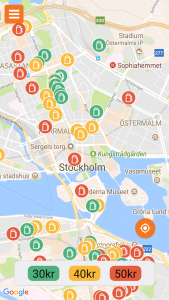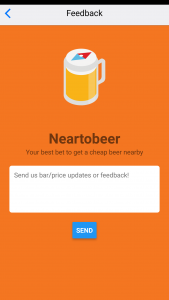My reflections on Business Development Lab
The goal of the Business Development Lab course is to create a business from scratch during the spring semester. I had high expectations for the course because I am an entrepreneur at heart and was hoping to finally get so far that one of my startups would actually get customers. Before this course I have been working seriously on three other startups. Visibike, the latest startup I founded is still going strong, albeit without me. I didn’t find a way to work on that startup during this course because of so many team members outside of KTH. Last year I have also had the opportunity to attend a similar course in Aalto University called CSE-E5888 Design Project, that course was perhaps more focused on the value proposition instead of business model but in the end we also had a demo gala with a pitching competition. I will now tell you what I learned during the journey of the NearToBeer team.
I’m a fan of the lean startup philosophy. Always when constructing a pitch or filling in the business model canvas I start questioning what parts I can really prove. One challenge with validation is that most of the time the results will not be promising. You often get a lukewarm response to your ideas, so it can be hard to decide which ideas to pursue.
We did a lot of validation and pivots during the first month trying to find painful problems in many user segments and markets. We tried to solve the housing situation in Stockholm, that proved too difficult. We were looking at problems of immigrants and to make a long story short the ones with money didn’t have any problems worth solving and those without money have a lot of problems, but we won’t get any money from them. It is always a good learning experience when you get out of the building and interact with potential customers, but we may have overdone it because of hesitating to move forward. It was apparent on week 9 that beer prices are too high in Stockholm and non-locals like ourselves didn’t know the bars we could get an affordable beer and have a good time.
On week 12 we finally settled on the idea of creating an app that lists the cheapest beers nearby. We had already spent 2 months just to come up with what to do so it was high time to start creating our product. This is where we got lucky and I got to experience again how important a good mentor is.
Hannes, Thomas and Johan are the people behind Beers Under Thirty, an app that lists the cheapest beers in Stockholm. We didn’t know of their existence before Michelle Maffei told us about their app and I reached out to them. They were very helpful for our team. They gave us access to their bar listings and gave us free reins to start developing our service under a new brand. We developed the app from scratch and worked on the business model, which proved to be the most challenging part. With the help of our mentors we got the app up to standard and their feedback helped us shape the NearToBeer brand and thinking about our go-to-market strategy. I have similar experiences from my earlier startups. Getting a good mentor or coach may be the only way to get focus and direction for inexperienced entrepreneurs. That’s why organisations like KTH Innovation and Aalto Entrepreneurship Society are crucial in creating innovation hubs. New entrepreneurs need guidance and very often a firm push to the right direction.
A good personal lesson I got was how hard it is to work in a large team. I think the greatest challenge is to activate every member and let them have something meaningful to do. Maybe a mistake our team made was not to give clear roles and responsibilities for each team member. With the available workforce we should have been able to get much further and even avoiding the crunch time towards the end of the course. Clear milestones and firmer deadlines would have been good for avoiding the last crunch time. We were not the only ones struggling with time management. It was apparent that many teams were very tired during the final pitches. We created milestones, but they were slipping all the time. We should have been able to release the app a month earlier and spent the rest of the time growing our user base and get in touch with potential customers and partners.
Working for almost half a year on a project proved a good reminder how hard entrepreneurship really is and how much work it takes to successfully launch a business. It’s funny in a way that the pitches in the 48 hour workshop during the autumn semester were not that different from the pitches we saw during the final presentations in Business Development lab. Only a few teams could really boast with their traction after 6 months of work. Congratulations to the Breasy team for the funding they secured!
The reason I think why entrepreneurship is hard because of the total freedom you have. You can feel that the company needs to branch out in thousands of directions to cover everything. I feel that focus is the single biggest issue for me as an entrepreneur. I don’t know what is the best course of action and what should be prioritized. That is why step-by-step approaches are great. I think this is a good time to start comparing my experiences between Aalto university’s Design Project course and KTH’s Business Development Lab.
The Design Project was arranged in two weeks sprints. The sprint started with a 2-hour lecture on Monday that gave us the theoretical framework and usually a guest speaker that gave us the best practical tips to get started. Every team also got a biweekly meeting with their mentor from the course’s industry partners, they did invest their time in us because mentoring is a good recruitment channel. Every sprint had a set of deliverables that every team posted to shared folders before the end of sprint pitches. The pitch sessions were held on the last Friday of the sprint. The format was a five minute pitch per team and 2 minutes for feedback and questions. So the pitches were over pretty fast and after a short break the one-to-one feedback sessions begun. The teams rotated every five minutes through the teachers, mentors and a peer feedback station where the teams had the chance to guide each other. It was a very structured way of working towards a minimum viable product and it suited my way of working very well. I also think the regular deadlines with clear goals helped keeping the teams on track. You can judge the end results for yourself by looking at the final pitches of the Design Project course at http://areena.yle.fi/1-3480439. Curio, Uutiskylpy and my pitch for team Fura won the competition and got a grade raise.
I think Business Development Lab gives a lot more freedom to the teams. Some teams will thrive because they are able to work on the aspects that really matters to them. Then again some teams will fail because they get overwhelmed with all the things that needs to be done. I think the Beta Submission in Business Development Lab was the wake up call for many teams. Talking with most of the teams they all thought they did a poor beta submission. But after that failure the rebound effect was strong and every team had something worth showing in the final pitches. The course compendium had homework listed for every lecture, but because there was no imperative to submit anything the homework was mostly ignored on my part. So my recommendation for the next year would be to increase the amount of deliverables, at the very least adding an Alpha submission. I would also like to have more pitching in the course. Several final pitches didn’t get their point across and had unrealistic projections. For many teams it was the first real pitch in the course and I’m sure that the next iteration would have been significantly better. Pitching will improve your communication skills, but I also think that crafting and giving a pitch is a lot better way to poke holes in your idea than filling a business model canvas.
I will continue working on NearToBeer as a hobby project that may become something bigger in the future. The first step is to keep on polishing the app and introducing more user interaction. That is something I enjoy doing because I find coding a good way to relax and it makes me happy to think that the app will create value to its users. I’m also betting that the technological expertise I gain by working on the project will prove useful for whatever future ventures I will pursue. So I didn’t yet manage to get customers for my startup as I had hoped for in the beginning, but I still feel the course was well worth the effort.
Extracurricular activities
As I understand it we were supposed to share our online and offline activity outside class. Here are some events I participated in and other contributions worth mentioning:
Liked it? Why not to share then?











